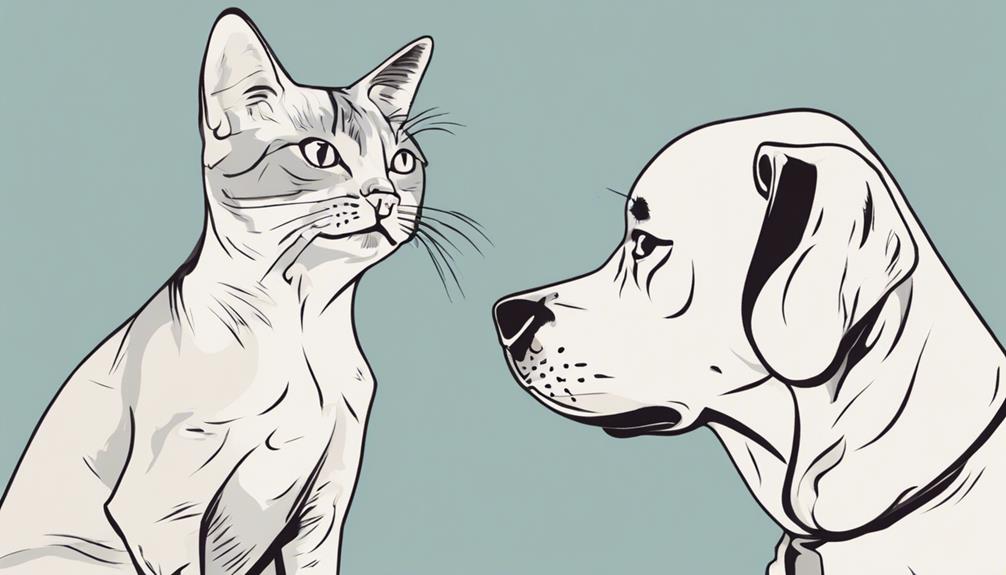What's the Truth: Can Dogs Communicate With Cats?
You might think that dogs and cats have such different behaviors that communication between them is impossible. However, observing their interactions might surprise you.
From subtle body language cues to unique vocalizations, these pets might be more in sync than you realize. As you delve into the intricacies of their communication styles, you'll begin to uncover a fascinating world of potential understanding between these two beloved furry companions.
Can Dogs Understand Cat Signals?
Understanding cat signals is something many dog owners wonder about, as it can provide insight into the potential for communication between these two animals. Cats and dogs use a variety of nonverbal cues to interact, and deciphering these signals can help bridge the gap in interspecies communication.
Observing their body language and vocalizations can offer valuable clues about their intentions and emotions. Cats often communicate through subtle movements like tail flicks, ear positions, and eye contact, while dogs rely more on gestures such as wagging their tails or bowing playfully.
By understanding these animal behavior patterns, you can enhance the harmony between your companion animals. Although cats and dogs have different ways of expressing themselves, learning to interpret their signals can foster better relationships and prevent misunderstandings.
Body Language Cues Between Dogs and Cats
Cats and dogs often communicate through subtle body language cues that can reveal their intentions and emotions. Visual cues play a significant role in their nonverbal communication and understanding of each other's social signals.
Dogs may use a combination of body postures, facial expressions, and tail movements to convey messages to cats. For example, a dog wagging its tail loosely may signal friendliness, while a stiff, upright tail could indicate alertness or aggression.
Cats, on the other hand, often communicate through their posture, ear positions, and eye contact. A cat with flattened ears and dilated pupils may be feeling threatened or defensive, while a cat with a relaxed body posture and half-closed eyes is likely content and at ease.
Understanding these body language cues is essential for fostering positive interactions between dogs and cats. By being attentive to the visual signals they exchange, you can help create a harmonious environment where both pets feel understood and respected.
Vocal Communication Differences
Dogs and cats communicate differently through vocalizations, which play a significant role in their interactions. Vocalization differences between dogs and cats can lead to communication challenges. Dogs tend to bark, growl, whimper, or howl, while cats communicate through meows, purrs, hisses, and yowls.
When dogs and cats interact, these vocal signals may not always align, creating language barriers and misinterpretation risks. For example, a dog's enthusiastic bark might be perceived as a threat by a cat, causing the cat to hiss or arch its back in fear. Conversely, a cat's friendly purr could be misunderstood by a dog, leading it to misinterpret the cat's intentions and respond inappropriately.
Understanding these vocalization differences is crucial for pet owners to facilitate positive interactions between dogs and cats. By paying attention to the nuances of vocal communication and being mindful of potential misinterpretations, you can help your pets communicate more effectively and build stronger relationships.
Olfactory Communication in Pets
Transitioning from vocal communication differences, pets also rely heavily on olfactory cues to communicate with each other and their environment. Scent recognition plays a crucial role in how animals interact and understand the world around them.
Here are some key points to consider about olfactory communication in pets:
- Power of Scent: Animals have a remarkable ability to recognize scents, allowing them to identify individuals, mark territories, and even detect danger.
- Emotional Signaling: Through scent, pets can convey emotions such as fear, happiness, or stress to others in their social group.
- Barriers to Communication: While scent is a powerful tool, communication barriers can arise when pets are unable to interpret or respond to certain olfactory signals effectively.
- Adaptation and Learning: Pets can adapt and learn to understand new scents over time, improving their communication skills and enhancing their social interactions with other animals.
Behavioral Responses to Each Other
Engage with each other through a variety of behavioral responses to establish social hierarchies and foster relationships. Dogs and cats both exhibit complex social hierarchy dynamics when interacting with each other. Dogs often display submissive behaviors towards cats, recognizing the feline's tendency for territorial behavior. Cats, on the other hand, may assert dominance through body language and vocalizations, shaping the dynamics of their relationship.
Play interactions between dogs and cats can vary greatly, influenced by their predatory instincts. Dogs might engage in playful chasing or wrestling, mimicking hunting behaviors, while cats may exhibit stalking or pouncing movements. Understanding these instinctual behaviors can help prevent misunderstandings between the two species during playtime.
It's important to monitor their interactions closely to ensure that both animals feel safe and comfortable. By recognizing and respecting each other's boundaries, dogs and cats can coexist harmoniously, forming unique bonds based on mutual understanding and respect.
Mutual Understanding Possibilities
To foster mutual understanding between dogs and cats, observe their interactions closely for cues on how to facilitate harmonious coexistence. Both species share instincts that can help them communicate effectively without words. Pay attention to their nonverbal cues, such as body language and vocalizations, to decipher their intentions and feelings towards each other. Understanding these signals can enhance the way you mediate their interactions and promote a peaceful environment for both pets.
Additionally, interspecies relationships rely heavily on social dynamics, which can be intricate and fascinating to witness. Dogs and cats have different ways of forming bonds and establishing hierarchies within their shared space. By recognizing and respecting these dynamics, you can create an environment where both animals feel secure and valued.
Cross-Species Bonding Dynamics

Understanding the dynamics of bonding between different species such as dogs and cats requires careful observation and interpretation of their behaviors and interactions. Interspecies friendships can develop between dogs and cats, characterized by mutual respect and companionship. Dogs and cats can form emotional connections that go beyond mere tolerance, often displaying affection and empathy towards one another.
In cross-species relationships, social hierarchy and pack mentality play crucial roles. Dogs, being pack animals, may exhibit protective instincts towards their feline companions, while cats, known for their independent nature, may establish boundaries within the relationship. Despite these differences, dogs and cats can coexist peacefully and even thrive in each other's company.
The key to fostering positive cross-species bonding dynamics lies in providing a safe and harmonious environment where both animals feel secure. By understanding and respecting each pet's individual needs and behaviors, you can nurture a strong bond between your dog and cat based on trust, companionship, and shared experiences.
Factors Influencing Interactions
Factors influencing interactions between dogs and cats stem from their inherent instincts and individual personalities, shaping the dynamics of their relationship. Environmental influences play a significant role in how dogs and cats interact, as their surroundings can affect their behaviors and comfort levels. Social dynamics within the household or their shared space also impact how they communicate, with hierarchy and territory being key factors.
When considering individual personalities, dogs and cats bring their unique traits to the table, influencing how they engage with one another. Past experiences play a crucial role in their interactions, as previous positive or negative encounters can shape their current relationship.
- Trust: Building trust between dogs and cats requires time and patience, influenced by their past experiences and comfort levels.
- Body Language: Understanding each other's body language is crucial in fostering positive interactions and avoiding misunderstandings.
- Routine: Establishing a routine that accommodates both pets' needs can create a harmonious environment for interactions.
- Positive Reinforcement: Using positive reinforcement techniques can encourage desirable behaviors and strengthen the bond between dogs and cats.
Frequently Asked Questions
Can Dogs and Cats Understand Each Other's Emotions?
When it comes to animal psychology and emotional intelligence, dogs and cats might surprise you. They're known to pick up on non-verbal cues and can have a deep level of inter-species bonding.
Understanding each other's emotions mightn't be as clear-cut as human communication, but they can definitely sense each other's feelings through body language and behaviors. Their ability to connect on an emotional level is a fascinating aspect of their relationship.
Do Dogs and Cats Have the Ability to Learn Each Other's Language?
When it comes to animal behavior and cross-species communication, it's fascinating to observe how dogs and cats interact. While they may not learn each other's language in the way humans do, they can still communicate through body language, sounds, and behavior.
Dogs and cats have their own unique ways of understanding and responding to one another, creating a dynamic and often mysterious form of communication that goes beyond words.
How Do Dogs and Cats Establish Boundaries With Each Other in Terms of Communication?
When dogs and cats interact, they establish boundaries through communication signals. Dogs may use body language like stiffening up or growling to set limits. Cats, on the other hand, might hiss or swat to communicate boundaries.
Understanding these cues helps both pets coexist peacefully. By respecting each other's signals, they can avoid conflicts and maintain a harmonious relationship.
Are There Any Specific Communication Signals That Dogs and Cats Use Exclusively With Each Other?
When dogs and cats interact, they've specific communication signals that are unique to their dynamic. Body language and vocal cues play a crucial role in their exchanges.
Dogs may use wagging tails and play bows to show friendliness, while cats might flick their tails or purr as a sign of comfort. These signals help them establish boundaries and understand each other's intentions, fostering better communication between the two species.
Can Dogs and Cats Sense Each Other's Intentions Through Their Communication Methods?
When it comes to dogs and cats, body language cues play a significant role in their interspecies communication. They can sense each other's intentions through nonverbal signals. This mutual understanding is often based on subtle movements, postures, and facial expressions.
Dogs and cats may not speak the same language, but they've a remarkable ability to decipher each other's nonverbal cues, fostering a unique form of communication between these two species.
Conclusion
In conclusion, while dogs and cats may not communicate in the same way as humans do, they're able to understand each other through body language, vocal cues, and scent.
Their unique ways of communication allow for a level of understanding and bonding that transcends species boundaries.
So next time you see your dog and cat interacting, know that there's a silent language being spoken between them that only they can understand.
